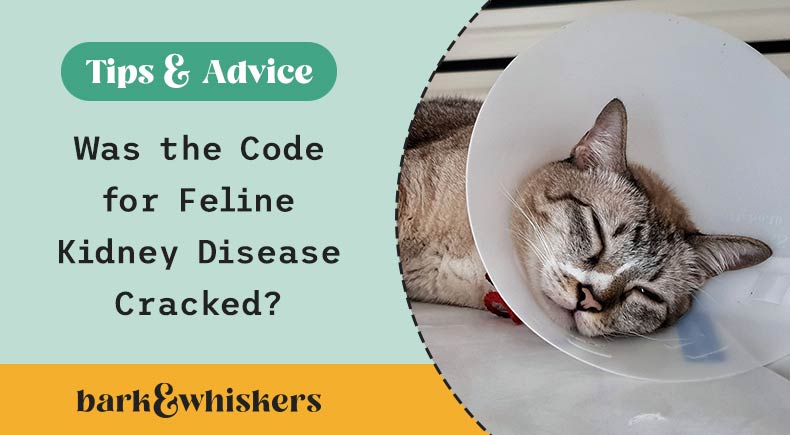Did This Professor Crack the Code for Feline Kidney Disease?
According to this Japanese immunologist, a protein produced by immune cells called AIM may be a potential trigger for feline chronic kidney disease (CKD), which affects over 50% of cats 10 years and older. While it's an exciting discovery, I still stand by these three time-tested recommendations.

STORY AT-A-GLANCE
- Japanese professor Toru Miyazaki has discovered a potential trigger for feline chronic kidney disease (CKD) that involves the protein AIM (apoptosis inhibitor of macrophage), also known as CD5-like (CD5L); AIM is a secreted protein in the blood that supports kidney health by identifying, destroying, and removing dead cells and other debris that accumulate in the body
- In many cats, it seems the AIM protein can’t do its job properly because it binds too tightly to IgM [immunoglobulin M] antibodies, which impedes its ability to dissociate from the antibodies and attach to the problematic debris to initiate the cleansing process
- Miyazaki has collaborated with both an ultraprocessed pet food producer and a pharmaceutical company in Japan to develop a food+drug companion therapy to prevent and treat CKD in cats; however, complete information on the professor’s “A-30” proprietary ingredient is currently lacking
- Until we know much more about the professor’s discovery and therapy, my time-tested recommendations to help cats avoid kidney disease remain the same: an excellent quality, moisture-rich, fresh food diet; appropriate natural supplements; and a minimalist approach to vaccinations
It is estimated that most senior cats (over 50%) 10 years and older have chronic kidney disease (CKD). There are a variety of underlying reasons for this disease epidemic in feline family members, not the least of which is the feeding of ultraprocessed dry food diets.
Another potential trigger for feline CKD appears to involve the protein AIM (apoptosis inhibitor of macrophage), which is produced by immune cells known as macrophages. The role of AIM is to clean and expel waste matter from the kidneys. When this protein isn’t properly activated, it leads to kidney problems and shortened lifespans in cats, according to Japanese immunologist Toru Miyazaki, a professor at the University of Tokyo’s Graduate School of Medicine.
“AIM adheres to and ‘flags’ the debris so that macrophages can ingest and destroy it more efficiently,” explains Miyazaki in an interview with Nippon.com. “It targets dead cells that can build up in renal tubules and cause kidney failure, as well as amyloid beta plaques that can cause Alzheimer’s disease.”1
Miyazaki believes that AIM could hold the key to controlling and treating a wide range of conditions, from obesity to liver cancer.
Why the AIM Protein Is Often Dysfunctional in Cats
Miyazaki discovered AIM protein in the 1990s. Also known as CD5-like (CD5L), AIM is a secreted protein in the blood that supports kidney health by identifying, destroying, and removing dead cells and other debris that accumulate in the body.
However, while AIM is bound to IgM (immunoglobulin M) antibodies, it can’t do its clean-up work, and according to a 2016 study co-authored by Miyazaki, the AIM-IgM binding affinity in cats is 1,000-fold higher than that in mice due to the unique positively charged amino-acid cluster present in feline AIM.2
“The AIM molecules that circulate in the blood are bound to IgM [immunoglobulin M] antibodies,” Miyazaki explains. “When there’s waste matter or debris that needs to be removed, the AIM protein launches from the IgM like a jet fighter from an aircraft carrier. It attaches to the problematic debris, flagging it so that the cleansing process can begin.
We found that in cats, the AIM is too tightly bound to the IgM to launch, and as a result, the debris doesn’t get cleaned up.”3
When the AIM and IgM don’t dissociate (become unattached), the dead cells and debris in the cat’s system don’t get destroyed and cleaned up, which is why, according to Miyazaki, so many cats develop acute kidney injury or other kidney-related diseases.
On the Horizon: AIM Diet and Drug Therapy?
In the fall of 2021, during the COVID pandemic, Miyazaki ran out of funding for his feline AIM research, but thousands of Japanese cat lovers stepped up and donated almost $2 million to the University of Tokyo so the professor could continue his work.
Miyazaki partnered with Osaka-based Marukan Co., Ltd. to develop a range of cat food (“AIM30” kibble) containing the amino acid A-30. It’s the A-30’s job to disassociate the AIM from the IgM so the protein activates and cleans up the kidneys.
The pet food company did a soft launch in March 2022 and has since developed a full line of AIM30 cat food that is now distributed all over Japan. By September, Marukan had added a new fish flavor for kittens and announced a lineup of supplements and treats containing A-30.
The company stresses that AIM-30 is “a comprehensive maintenance nutritional food,” not a therapeutic food, and people with cats eating therapeutic diets should consult a veterinarian before feeding AIM30.
Miyazaki also partnered with a pharmaceutical company to develop a prototype drug. That drug is currently being trialed and if successful, will be submitted for Japanese government approval. According to Miyazaki, cats given the supplemented food and companion drug from the time they’re kittens can potentially double their current average lifespan of about 15 years through improved renal function.
Much More Information Is Needed Regarding This Therapy
While I applaud Professor Miyazaki’s research into the link between inefficient AIM protein functioning and chronic kidney disease in cats, I’d like to know much more about the proprietary ingredient “A-30” he developed with the pet food company Marukan, as well as the companion pharmaceutical currently under review.
It’s certainly possible this therapy could be beneficial in the prevention and treatment of feline CKD, but I’m not encouraged by what I’ve been able to find about the commercial diets.
The food appears to a line of kibble formulas, with the usual low-quality feed-grade ingredients, presumably produced like all kibble using high heat processing and extrusion. Per the Product Introduction on Amazon.com, "A-30" is an amino acid “developed based on the results of Professor Toru Miyazaki,” but there appears to be no mention of it in the ingredient list (as translated from Japanese):
Corn, glutenmeal, chicken, beef, pork, animal oil, wheat flour, fish extract, roast mani, dietary fiber, vegetable oil, yeast, chicken lever powder, starch powder, tuna and bonito shaved powder, lactic acid bacteria, agaryx, cranberry, sesamin, minerals (Pa, Cl, Ca, K, Zn, Fe, Cu, Co, Mn, I), amino acids (Cystine, Methionine, Taurin), Vitamins (AB1, B2, B6, B12, C, D3, E, K3, Colin, Nicotinate, Pantothenate, Biotine, Folic Acid), Seasoning, Antioxidants (mix tocopherol, herb extract).
I’ve been unable to find out anything more about “A-30” as either a pet food ingredient or a medication. If and when there is more information available about these products, both the food and the medication, I can comment further, but until then, I’ll continue to offer my time-tested advice to help feline family members avoid kidney disease.
Kibble Can Lead to Chronic Dehydration and Kidney Stress
The essential nature of the feline species demands that they meet most or all their hydration requirements through their diet, not at the water bowl, which is why they don’t have the thirst drive of other species. Ultraprocessed kibble — the furthest thing from optimal feline-specific nutrition — provides a very small percentage of the moisture cats need in their daily diet.
Kitties fed an exclusively dry diet often suffer chronic mild dehydration that causes significant stress to the kidneys over time. As Dr. Lisa Pierson, a feline-only practitioner and cat nutrition expert, writes at her informative CatInfo.org website, “It is troubling to think about the role that chronic dehydration may play in causing or exacerbating feline kidney disease.”
In addition, the quality of high heat-processed protein in dry pet food is very poor. It’s rendered, feed-grade protein, which is harder for cats to digest and process.4 Fed twice a day (or all day) every day for years, it can cause stress to the liver and kidneys. The high heat processing these products undergo also creates an abundance of advanced glycation end-products, which have been linked to kidney disease in animal models.
Certain Vaccines May Also Damage the Kidneys
When I interviewed Dr. Lisa a few years ago, I asked her for her thoughts on what’s behind the epidemic of feline CKD.
“That’s a fabulous question I wish I had the answer to,” she replied. “We do know that a well-respected researcher, Dr. Michael Lappin at Colorado State University, has established a possible link between feline kidney disease and the feline viral rhinotracheitis, calicivirus and panleukopenia (FVRCP) vaccine, which is grown in feline kidney cell cultures.
We really want to be very careful not to over-vaccinate cats, because it can possibly set up an autoimmune type of reaction to their own kidney cells. Having said that, my own cats still developed kidney disease.
I assure you they were not over-vaccinated. They got vaccinated as kittens. They passed away between 18 and 20 years of age. They were never vaccinated again after their kitten shots, yet they still got kidney disease. They were not on dry food. They were on a water-rich diet. So, the short answer to your question is, ‘I don’t know, but I wish I did’.”
An important point to make here is that as Dr. Lisa’s situation demonstrates, we can do everything right and our cats may still acquire a debilitating disease, including kidney disease. Many parents of sick cats say, “I don’t know what I’ve done wrong.” Often, they’ve done nothing wrong. Even in optimal environments, cats can and do get sick.
Asking your veterinarian to perform vaccine antibody titers instead of automatically vaccinating an indoor housecat makes sense, as your pet’s exposure to other kitties harboring potentially infectious diseases is basically non-existent.
Dietary Protein Does NOT Cause or Worsen CKD
Per Dr. Lisa in our interview:
“With regard to how protein affects the kidneys, it’s important to understand protein is not the enemy of the cat kidney. Protein doesn’t cause kidney disease. It doesn’t exacerbate kidney disease. It is not the enemy of the kidney.
If there’s one take-home message I want to get across, it’s ‘Please stop vilifying protein!’ I would not feed any of the protein-restricted, so-called “prescription” diets to any cat in my care. There are always better options.”
Once a cat is diagnosed with chronic kidney disease, often veterinarians recommend a prescription “renal diet,” many of which are dry diets (e.g., Hill’s k/d). This has never made sense to me. These formulas don’t meet the dietary hydration requirements of cats, especially kitties who are losing large amounts of water due to worn out kidneys.
“I must say that I find it truly amazing when I hear about the very large numbers of cats receiving subcutaneous fluids while being maintained on a diet of dry food,” Dr. Lisa writes at CatInfo.org. “This is an extremely illogical and unhealthy practice and every attempt should be made to get these cats on a diet that contains a higher moisture content.”
Prescription renal diets also typically have reduced levels of protein, which is not ideal for cats, who are obligate (strict) carnivores requiring high levels of high-quality animal protein for optimal health. According to Pierson:
“Renal diets restrict protein to the point that many cats — those that are not consuming enough of the diet to provide their daily protein calorie needs — will catabolize (use for fuel) their own muscle mass which results in muscle wasting and weight loss.
This internal breakdown of the cat’s own muscle mass will cause an increase in creatinine (and BUN) which needs to be cleared by the kidneys. The rise in creatinine and BUN, and muscle wasting, can lead to an often-erroneous conclusion that the patient’s CKD is worsening.”
Another important consideration is that contrary to what many people continue to believe, studies show aging pets, including those with kidney disease, need more protein, not less.5 But again, it must be very high-quality (human grade) protein (not found in most pet foods).
Cats fed a low quality ultraprocessed diet all their lives often grow addicted to it and refuse to eat anything else. If your CKD cat is hooked on a poor-quality food that is difficult to digest and process, then it may indeed be necessary to reduce the amount of poor-quality protein in the diet. A better idea is to slowly wean cats off highly refined dry food and onto fresher, moisture-rich diets.
However, if your cat is eating human grade (preferably antibiotic- and hormone-free) protein, then protein restriction prior to late-stage CKD is often counterproductive and can exacerbate weight loss and muscle wasting — two common health issues for cats with failing kidneys.
Ideally, if your cat is eating poor-quality food, the goal is to wean him off it and onto a better-quality diet so that adequate protein intake can be continued. I recommend a human grade, fresh food diet formulated for kidney disease, either homemade or a prepared diet like.
Darwin’s has created the only veterinary formulated therapeutic fresh food diet specifically for cats with CKD. It can be fed lightly cooked or raw. Unless your cat absolutely refuses to eat anything else, I don’t recommend feeding prescription dry “kidney diets”. You can also consider a nutritionally complete homemade diet that’s been specifically formulated for cats with kidney disease.
About Phosphorous Content
Phosphorus is an important mineral that plays a significant role in feline health. One of the jobs of the kidneys is to balance phosphorus levels in the body by removing the excess. In cats with renal disease this ability is compromised, and in fact, many CKD kitties ultimately develop hyperphosphatemia (abnormally high levels of phosphorus in the bloodstream). The goal is to keep phosphorus levels from climbing.
Renal diets are formulated with reduced phosphorus levels, which is important. There are additional ways to support kidney health over time, including adding natural phosphorus binders (such as chitosan), optimizing calcium levels to minimize absorption of phosphorus, and optimizing vitamin D and EPA/DHA levels.
Additional Recommendations
Specific vitamins can sometimes be beneficial for cats with chronic kidney disease. I often add B-vitamins to a cat’s sub-Q fluids (if required), or to their food, as a supplement. B-vitamins can help prevent anemia, relieve nausea, and improve a cat’s overall feeling of well-being.
L-carnitine and additional amino acids (such as RenAvast®) can help slow muscle wasting. Increasing intake of omega-3 fatty acids (DHA/EPA) may also help slow the progression of renal disease by reducing chronic inflammation. Adding a source of blood-building supergreens, such as chlorophyll or chlorella, can help fight a low red cell count.
I also recommend adding detoxification support, such as n-acetyl cysteine (NAC), dandelion, stinging nettle, and SOD (superoxide dismutase), if your kitty will consume it.
Probiotics that contain specific kidney supportive strains such as Lactobacillus acidophilus, casei, and plantarum, Streptococcus thermophilus, and Bifobacterium longum can also be extremely beneficial. These strains, which support healthy urea metabolism, are available in “kidney-specific” products, as well as OTC probiotics, so read labels carefully.
Glandulars can also be helpful. An integrative veterinarian can help you decide if these are indicated based on your cat’s specific situation.
Making your kitty’s environment as stress-free as possible is also extremely important. Reducing both emotional/mental stress, as well as household and environmental chemical stress is important. Offer filtered water, switch to nontoxic cleaning supplies, and remove airborne pollutants (candles, plug-ins, room sprays, sources of smoke).
And most important of all in the prevention or management of kidney disease is vigilant monitoring of organ systems. The goal should be to identify risks and subtle changes long before kidney failure occurs.
Completing an annual urinalysis and bloodwork (including SDMA testing) allows you to identify early changes in kidney function and begin supportive care months to years before your cat shows outward signs of kidney disease. Many cats live long full lives when kidney disease is identified early and managed proactively.
Sources and References
- PetfoodIndustry.com April 11, 2022
- PetfoodIndustry.com January 9, 2023
- 1,3 Nippon.com, November 17, 2021
- 2 Sugisawa, R. et al. Impact of feline AIM on the susceptibility of cats to renal disease, Scientific Reports, Volume 6, Article number: 35251 (2016)
- 4 Hamper, B.A. et al. Apparent nutrient digestibility of two raw diets in domestic kittens. J Feline Med Surg, 2016 Dec;18(12):991-996
- 5 Finko DR, et al. Protein and calorie effects on progression of induced chronic renal failure in cats, Mousabilities.com
Today's Pet Video:
Mama Dog and Puppy: She’s the Eyes and He’s the Ears
Finding a very sad, deaf mama dog and her mostly blind puppy abandoned by a river, a long journey ensued to get them to the U.S., get them well, and find them a good home.










